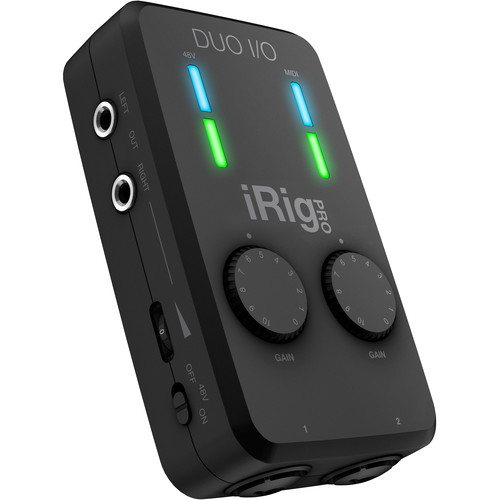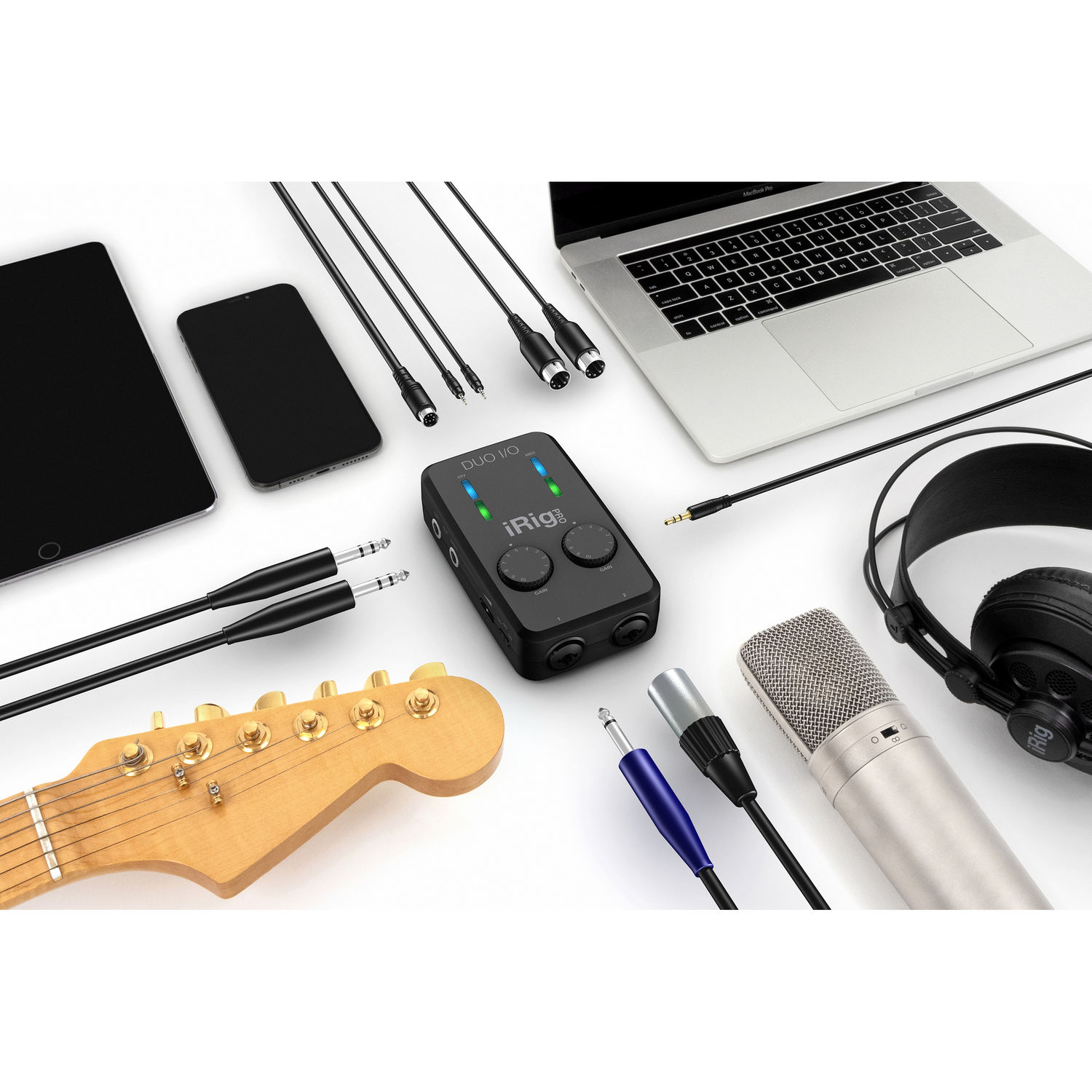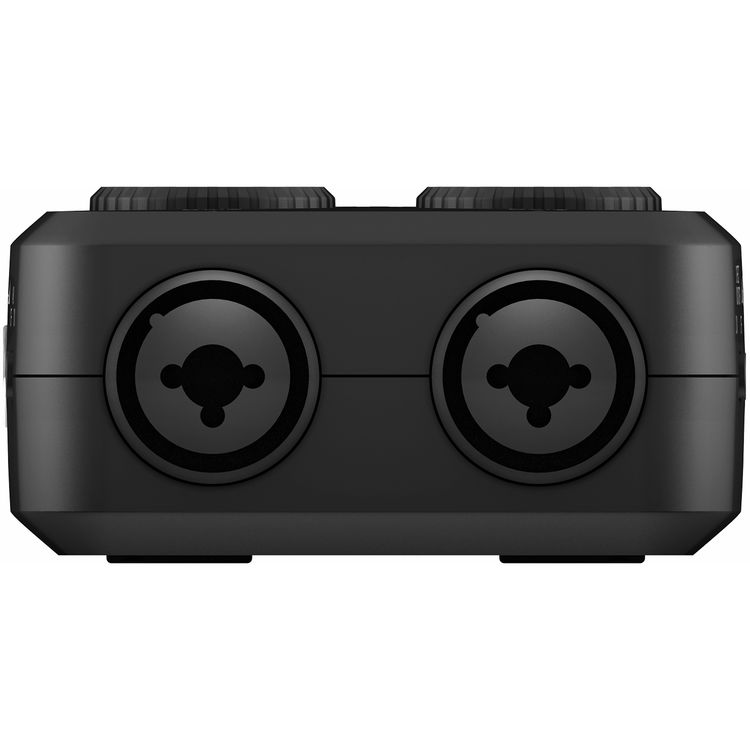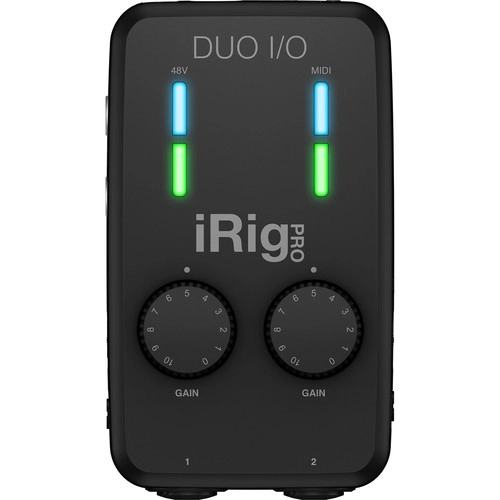Here is my review of the iRig Pro Duo I/O multiplatform portable audio interface, which handles up to two channels of audio XLR balanced audio and even MIDI. The iRig Pro Duo I/O indeed offers switchable phantom power for condenser mics that require it (or even for powering an external pre-preamplifier for extremely gain-hungry dynamic mics, if required). The iRig Pro Duo I/O features a pair of very clean preamps, ADC (analog-to-digital converters) and DAC (digital-to-analog converters), although with less available mic gain than the single channel iRig Pre HD I reviewed back in 2017, which is still available as a current product. I’ll also be deeply comparing the iRig Pro Duo I/O with the similar Saramonic SmartRig+ units I recently reviewed.
Truly multiplatform/what comes included
Unlike the Saramonic SmartRig+ offerings (recently reviewed here, which must be specifically ordered either with Lightning or USB-C), the iRig Pro Duo I/O is truly universal. The iRig Pro Duo I/O includes appropriate cables for USB-C, USB-A, Lightning and even MIDI (which I did not test personally, since I’m not a musician). This means that the same audio interface can be used with any modern smartphone/tablet (Android or iOS/iPadOS) or computer (ChromeOS, macOS, Windows). Here is a complete list of what comes included with the iRig Pro Duo I/O:
- Lightning to Mini-DIN connection cable (60 cm/23.62″)
- USB-C to Mini-DIN connection cable (60 cm/23.62″)
- USB-A to Mini-DIN connection cable (60 cm/23.62″)
- 2x 2.5mm TRS male to MIDI female adapter (10 cm/3.9″)
- 2 x 1.5V AA Battery
Purpose
To connect a maximum of two balanced microphones, which can be any combination of balanced XLR (with switchable 48-volt phantom power) and sends the signal(s) to the appropriate smartphone, tablet or conventional computer. You have individual gain control of each input, and each one is sent discreetly as 1 and 2 (Left and Right). Unlike the Saramonic SmartRig+, the iRig Pro Duo I/O does not offer any “mono” mode to combine and center the two input channels, which can be convenient for live broadcast or live-to-drive, when there is no time for any post production. However, even though the iRig Pro Duo I/O does not offer a “mono” mode, this can be achieved using inexpensive third party software (at least with macOS and Windows), so this is not a dealbreaker even if you need this functionality. I have personally used such software for macOS.
The two XLR inputs are also combo, so they accept unbalanced instrument-level sources via TS 1/4”.
Can I connect an unbalanced electret condenser microphone too?
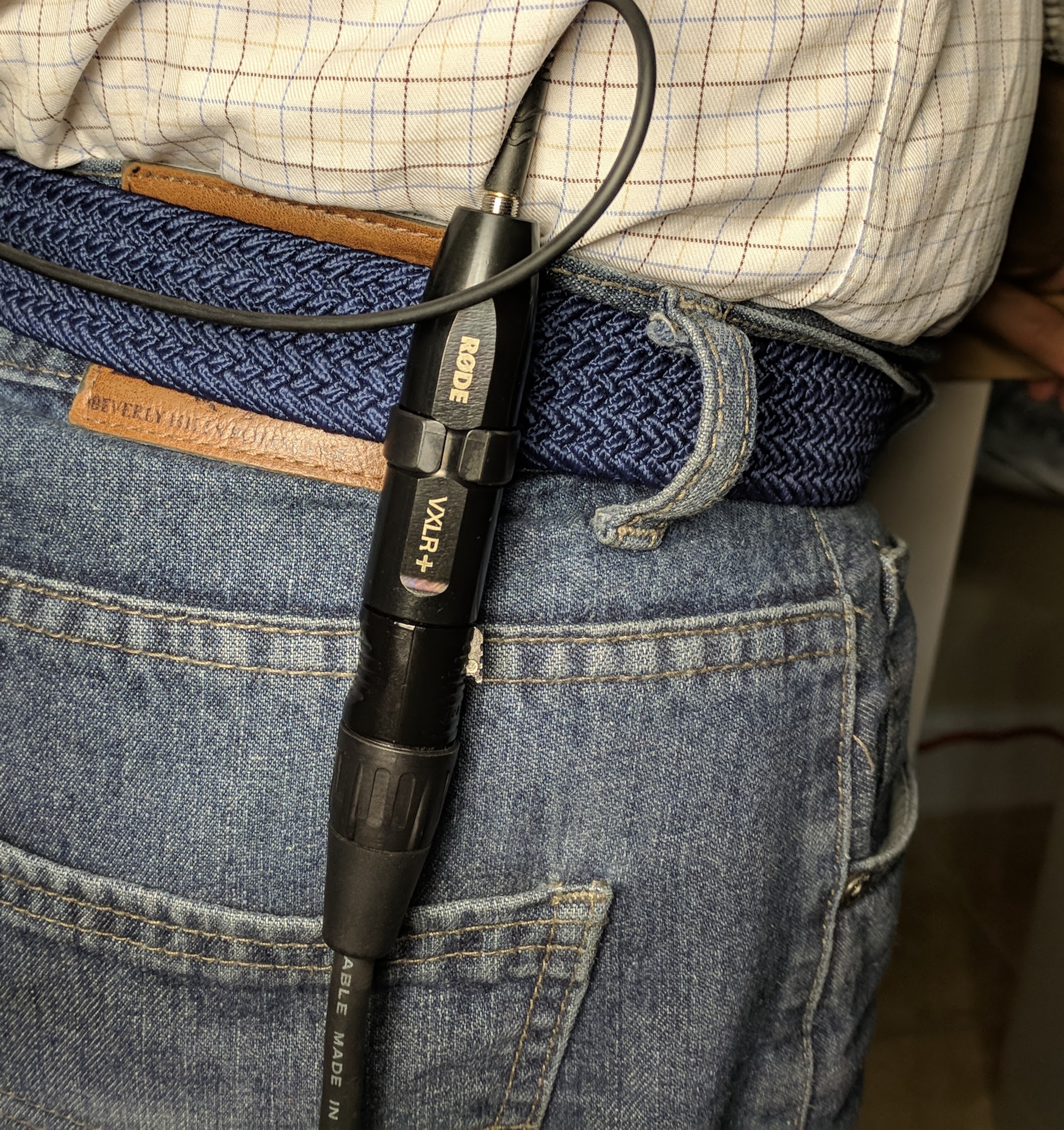
Yes, you can indeed connect an unbalanced electret condenser microphone to the iRig Pro Duo I/O, as long as you use a VXLR+ converter (illustrated above, covered in these articles). The VXLR+ accepts the 48-volt phantom power from the iRig Pro Duo I/O and converts it into lower voltage bias voltage (plugin power) for these microphones, while adapting the connections. I tested it with the iRig Pro Duo I/O and it worked perfectly well, either with an XLR cable or by plugging the XLR+ directly into the iRig Pro Duo I/O’s XLR input.
A very practical case where you might want to do this (as I have done many times before) is when I do a field interview, where I use a balanced XLR microphone for the interviewee, and I use an unbalanced head-mounted electret condenser microphone for myself. Because they are much close to the speaker’s mouth, head-mounted microphones generally have a higher signal-to-noise ratio than lavalier microphones mounted on the speaker’s clothing. Another advantage of head-mounted microphones is that they are often more immune to mechanical noise when the person speaking moves around. You may not know that you can transform any unbalanced electret condenser lavalier microphone (including the iRig Mic Lav from IK Multimedia) into a head-mounted microphone with the US$25 LAVHS from RØDE shown below:
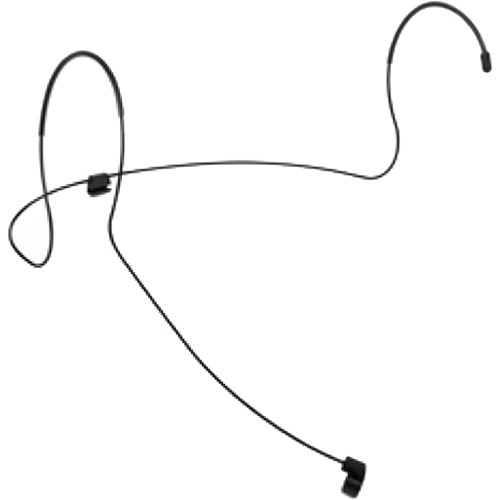
In the case of most lavaliers which terminate in TRRS (including the iRig Mic Lav from IK Multimedia), you need an adapter from TRRS to TRS before plugging into the VXLR+. IK Multimedia offers the iLine Camera Adapter to adapt from TRRS to TRS for ≈US$15, while RØDE offers the SC3 for US$15.
Preamps and potentiometers
IK Multimedia is one of those manufacturers that (to date) does not like to publish its maximum available gain from its microphone preamps. Instead, IK publishes the gain “range”, which in this case is 50 dB range. However, since the minimum potentiometer position is not zero gain, the maximum available is certainly higher than the published range. Back in 2017, I estimated the single channel iRig Pre HD to have +60 dB maximum available gain. Later, my colleague Bandrew of the Podcastage came to the same conclusion and even quoted me in his review at 2:32. Other manufacturers (like RØDE and Saramonic) sometimes publish a maximum gain which is much lower than my observations (they strangely underrate their own specs). This is something that RØDE did with its i-XLR, but later explained, as I covered in my review in 2016. With more recent products, I believe that RØDE’s maximum available gain has been much more accurate than with the i-XLR. Having said that, I am estimating that the maximum available gain of the iRig Pro Duo I/O to be +55 dB. That is because with the iRig Pre HD I had to set the gain to 64% to get a conservative -12 dB raw recording with a dynamic microphone, while with the iRig Pro Duo I/O, I had to set it at 90% to get the same -12 dB raw recording. In the case of the SmartRig+, I only had to set the potentiometer to 50% to get the same -12 dB raw recording using the same dynamic microphone. Even though IK Multimedia doesn’t publish the maximum gain of either of these two interfaces, the web page of the iRig Pre HD states “delivers outstanding results with even the most gain-hungry microphones”, but does not do this with the iRig Pro Duo I/O. This is likely not a coincidence. Someone at IK Multimedia must know that the maximum available gain of the iRig Pre HD is higher than that of the iRig Pro Duo I/O.
As I have covered in many past articles, we record at the conservative -12 dB for a raw recording, to leave headroom for unexpected loud sounds like laughter or screams. In my test recordings which you’ll hear ahead, I set the input potentiometer to 90% to reach -12 dB with my normal voice level close to the mic. Fortunately, the preamps sound quite clean even at 90%.
The input pots (potentiometers) of the iRig Pro Duo I/O turn almost 360 degrees and feel very solid (as the entire unit does). I also applaud IK for continuing to use numbers on their pots, which is something that Saramonic doesn’t do currently.
Monitoring: Latency free or playback
The iRig Pro Duo I/O offers either latency-free monitoring when recording/broadcasting live or playback to hear sounds coming from the connected device. This can be done simultaneously with the iRig Pro Duo I/O (you can’t with the Saramonic SmartRig+), although with some details I’ll explain ahead.
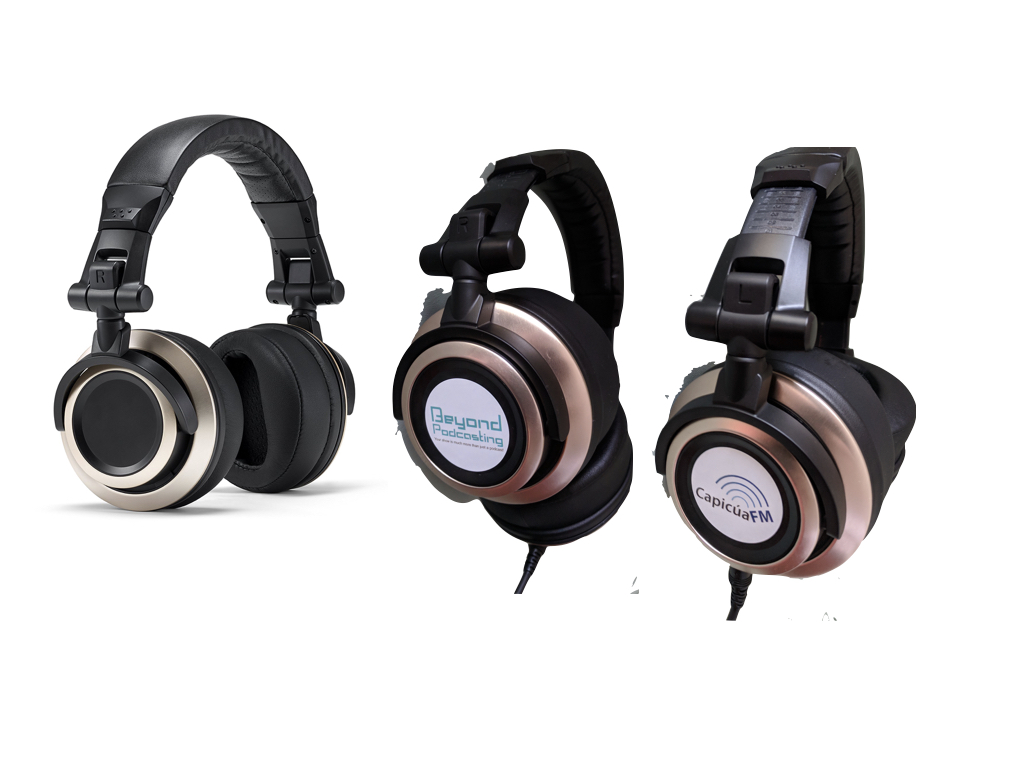
In addition, using my favorite CB-1 isolating headphones (shown above, rated at 32 ohms, reviewed here), the output level in my headphones fortunately was fine when recording at -12 dB, although I had to set the headphone volume on the iRig Pro Duo I/O to the max to hear myself well when recording. As a result, you should make sure that your connected isolating headphones are 32 ohms or lower to hear an adequate level in your headphones. The very popular Sony MDR-7506 is officially 63 ohms, although Ken Rockwell measured it to be even higher.
Details to keep in mind about this headphone output on the iRig Pro Duo I/O:
- Some audio interfaces or USB mics include a balance knob to set the percentage of sound to he heard in the headphones between the latency-free mic source and any return audio from the host device (smartphone, tablet or conventional computer) and some don’t. Others (including the iRig Pro Duo I/O) have an on-off switch for the latency-free monitoring. In the case of the iRig Pro Duo I/O, the switch is labeled DIRECT MONITOR. (If switched to Off, you still monitor the host device, but not the direct signal from your connected microphones) I have never been picky about this before, because the natural balance was always close enough for my taste. However, in the case of the iRig Pro Duo I/O, the balance was extremely different. If I played sound from the computer after moving the headphone volume to maximum to hear myself well, the playback from the computer was so loud it was nearly painful. Some apps have their own adjustments for audio playback level, and some don’t. If you need to use one of the apps that does not offer it, you will need to lower the volume of the iRig Pro Duo I/O headphone output to be low enough to be comfortable in your headphones. If and when you do that, your own voice heard in the headphones will be relatively much lower, making it more difficult for you to QC (perform quality control) while either recording or dealing with a remote guest… or being a remote guest or co-host in another producer’s show. This difference of monitoring level will certainly be less noticeable if you set your mic level to be hotter (higher) than -12 dB in those situations, although you will then have more risk of clipping if you laugh or react loudly to something. To do that with a dynamic mic, you may then have to set the gain to 10 (100%) and/or use a pre-preamp like the Simply Sound SS-1, Cloudlifter or Fethead. See my 2019 Review: Simply Sound SS-1 Pre-Preamp, Like Elevator Shoes For Dynamic Mics for details.
- With all dual-input interfaces I recall having tested, they all monitor the left channel source in the Left ear of stereo headphones, and the Right channel in the right ear of the headphones, except if the interface has a mono mode for recording, or a specific mono mode for monitoring. However, even though the Rig Pro Duo I/O does not offer any switch for mono of either type, when monitoring the discrete inputs are surprisingly centered in the connected stereo headphone. This is not a problem, but it is indeed worth noting.
Available sampling rates and resolutions
The iRig Pro Duo I/O offers both 48 kHz and 44.1 kHz, although I only tested using our standard 48 kHz/24-bit (see Enter the 48 kHz alliance). I would never use 44.1 kHz for the reasons explained there.
As I have covered in prior articles, to set your audio sampling on Android or iOS, simply select it in any of the recording apps that offer such an audio sampling selection (i.e. Auphonic, FiLMiC Pro, FV-5 Cinema) or use an app that uses 48 kHz exclusively, like the RØDE Reporter app. (Stay away from the native camera app or GarageBand, which only support 44.1 kHz, which is kryptonite for video production.)
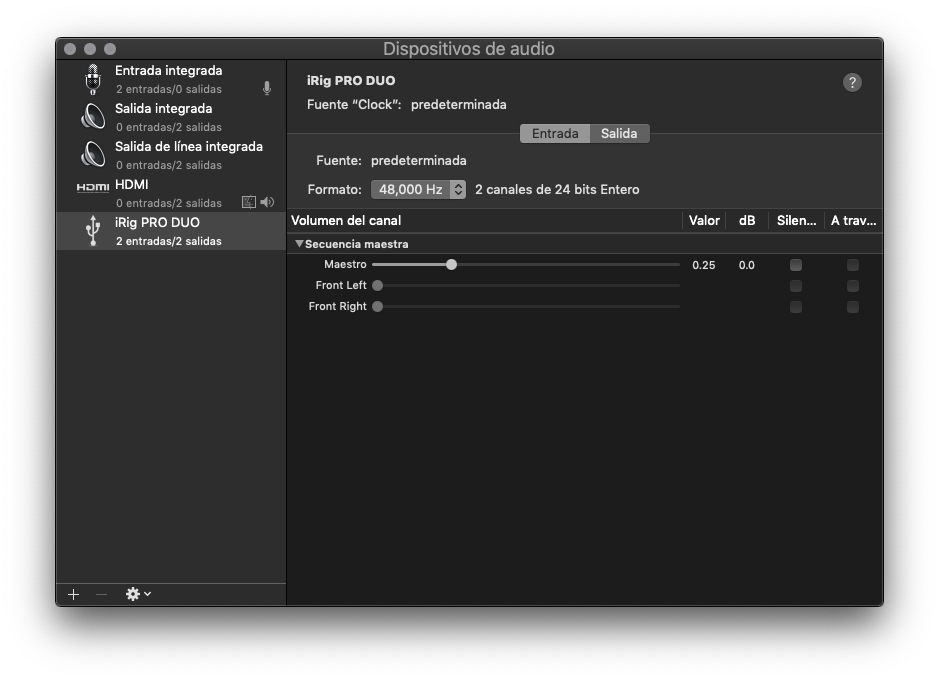
On macOS, first select 48 kHz in the Audio MIDI Setup (illustrated above) and then in your desired recording app.
Setting levels
Even though the Rig Pro Duo I/O does not have VU meters, it indeed has LED indicators to help use set the level properly. The lower multicolor LED on each channel is there for that purpose.
The upper left LED is to indicate whether 48 volt phantom power is active or not. The upper right LED indicates whether MIDI is active (which I did not test).
On the other hand, the Saramonic SmartRig+ lacks level indications at all.
Balanced line outputs
Thanks to its balanced audio output via TRS 1/4”, the Rig Pro Duo I/O can be conveniently used to connect to powered monitor speakers like the following from IK Multimedia:
- iLoud (reviewed by me here in 2014)
- iLoud Micro (reviewed by me here in 2016)
- iLoud MTM Pair (pending to review when I receive a review unit)
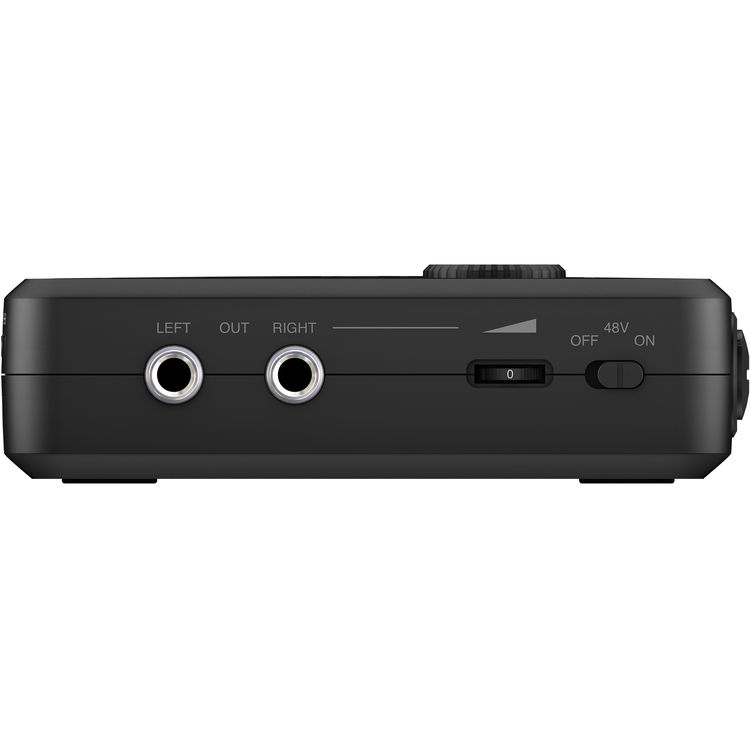
As shown above, this output fortunately has its own level setting on the corresponding side of the Rig Pro Duo I/O.
Test recordings
I connected a dynamic microphone to input 1 (Left), the headless Samson Q2U with the enormous Shure A81WS presidential windscreen (reviewed here, shown below).
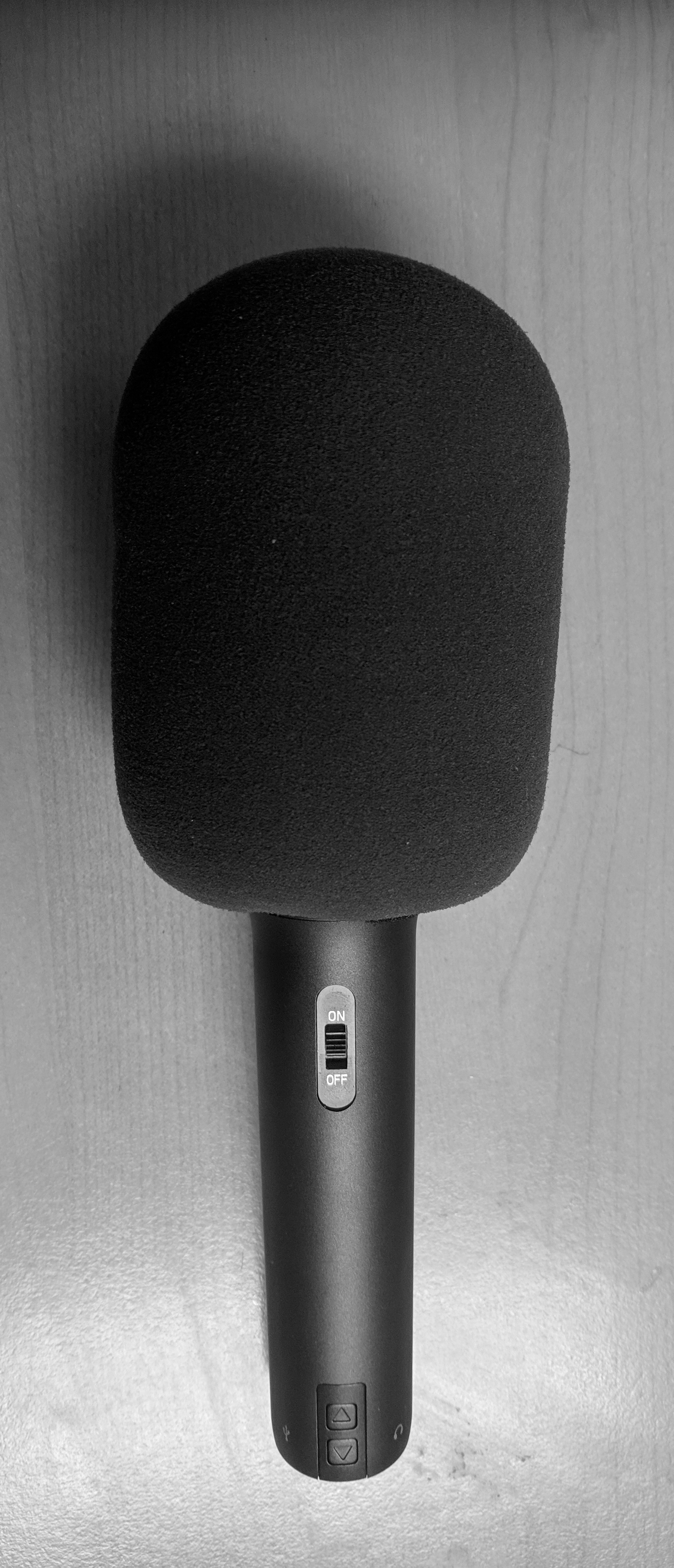
As indicated earlier, I set the gain input of the Left channel to 9 (90%) to get -12 dB for the raw recording using the meter in Hindenburg Journalist Pro. In Hindenburg Journalist Pro, I set the channel to record only from the left channel of the iRig Pro Duo I/O. All recordings below are WAV 48 kHz mono and normalized. Please use unmetered data to listen:
Audio PlayerAbove, headless Q2U via iRig Pro Duo I/O, flat.
Audio Player
Above, headless Q2U’s directly digital output, flat (to compare with the preamp and A-to-D converter in the iRig Pro Duo I/O).
Audio Player
Above, headless Q2U via iRig Pro Duo I/O, processed with mild noise reduction and mild compression from Hindenburg Journalist Pro.
Audio Player
Above, headless Q2U’s directly digital output, flat (to compare with the preamp and A-to-D converter in the iRig Pro Duo I/O).
Power
Even if used with a dynamic microphone without phantom power, the iRig Pro Duo I/O requires a pair of AA batteries (included). The battery life is quoted as:
- Recording – Max load*: 3 hours, 30 minutes (NiMH rechargeable); 45 minutes (Alkaline)
- Playback – Min load**: 10 hours (NiMH rechargeable); 3 hours (Alkaline)
*Max load condition: both inputs connected to two 1.5mA phantom powered loads, input gains set to maximum, outputs set to maximum.
**Min load condition is as follows: music playing, phantom power OFF.
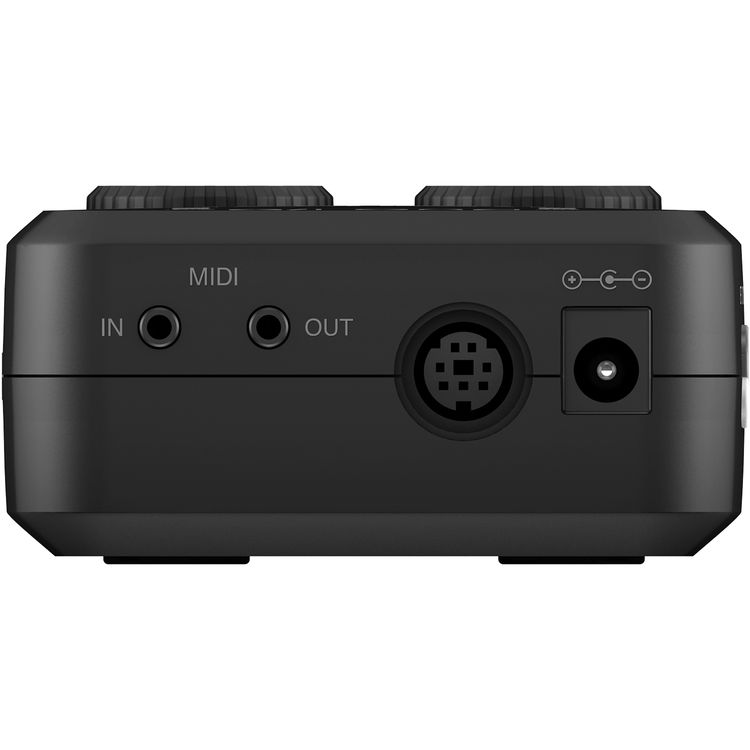
IK Multimedia also offers the optional iRig PSU 9175 external power supply for continuous use for ≈US$40.
Comparison chart
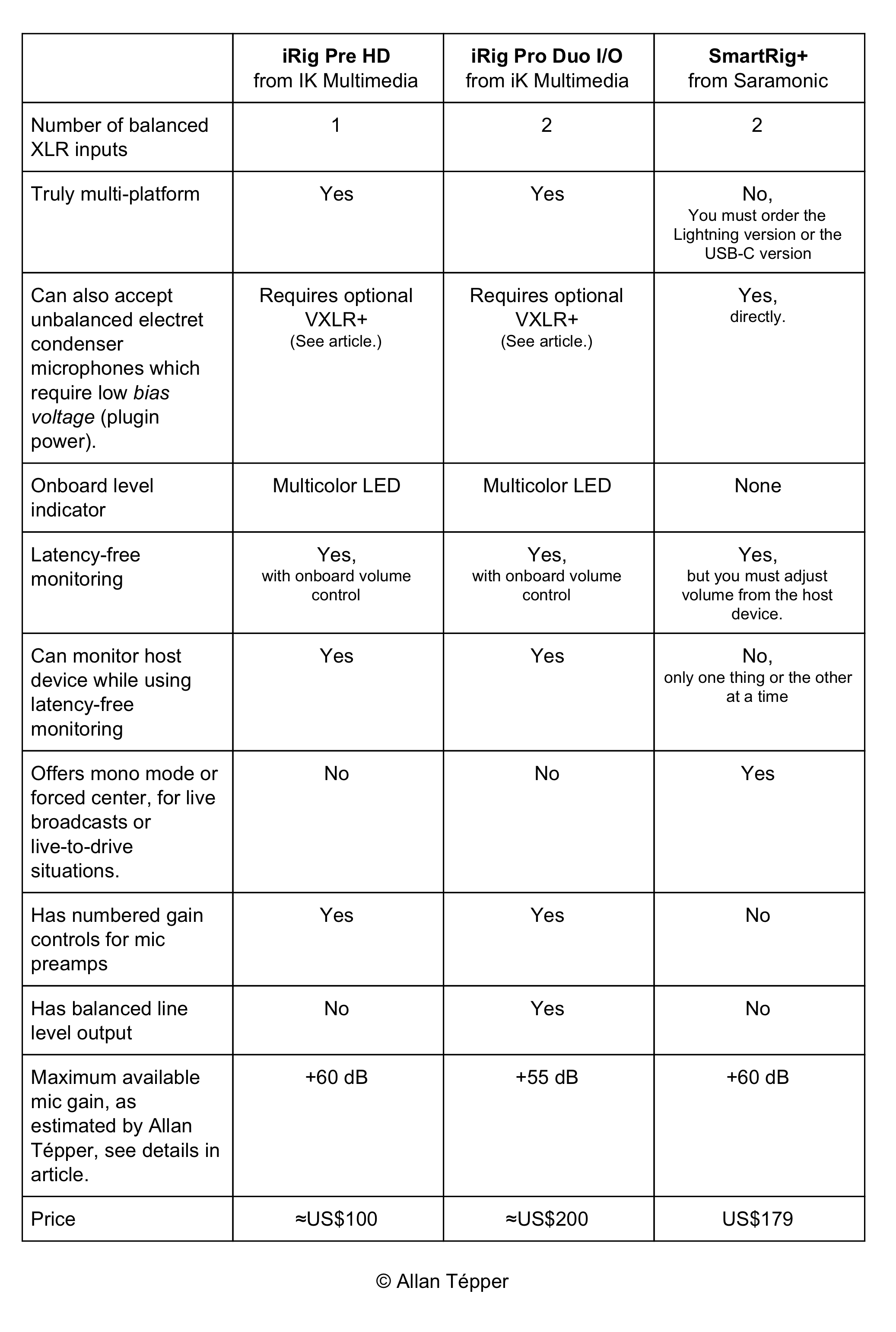
RATINGS
Looks and build quality

Connectivity

Zero-latency monitoring for local use only

Monitoring for use with a remote guest or when used by a panelist

Gain for dynamic mics

Sound quality in its price range

General conclusions
As you will have read in the comparison chart, the iRig Pro Duo I/O from IK Multimedia has at least six advantages over the SmartRig+ from Saramonic, although the latter has a few unique advantages which may be important for some very specific use cases. These can be overcome with the iRig Pro Duo I/O using external hardware (a VXLR+ for connecting unbalanced electret condenser mics and/or with an external pre-preamp in very extreme cases) or software (to force both channels to be mono or centered for live or live-to drive use, although only with macOS or Windows, not with Android or iOS/iPadOS as of publication time of this article, to my knowledge), as I have covered in the article. As you see those details, you’ll be able to determine which of those features are more important for you.
For more information on the iRig Pro Duo I/O, visit the IK Multimedia website directly here.
(Re-)Subscribe for upcoming articles, reviews, radio shows, books and seminars/webinars
Stand by for upcoming articles, reviews, books and courses. Sign up to my free mailing list by clicking here. If you previously subscribed to my bulletins and no longer receive them, you must re-subscribe due to new compliance to GDPR. Most of my current books are at books.AllanTepper.com, and my personal website is AllanTepper.com. Also visit radio.AllanTepper.com.
Si deseas suscribirte (o volver a suscribirte) a mi lista en castellano, visita aquí. Si prefieres, puedes suscribirte a ambas listas (castellano e inglés).
Suscribe to his BeyondPodcasting show at BeyondPodasting.com.
Subscribe to his award-winning CapicúaFM show at CapicúaFM.com.
FTC disclosure
No manufacturer is specifically paying Allan Tépper or TecnoTur LLC to write this article or the mentioned books. Some of the other manufacturers listed above have contracted Tépper and/or TecnoTur LLC to carry out consulting and/or translations/localizations/transcreations. Many of the manufacturers listed above have sent Allan Tépper review units. So far, none of the manufacturers listed above is/are sponsors of the TecnoTur , BeyondPodcasting CapicúaFM or TuRadioGlobal programs, although they are welcome to do so, and some are, may be (or may have been) sponsors of ProVideo Coalition magazine. Some links to third parties listed in this article and/or on this web page may indirectly benefit TecnoTur LLC via affiliate programs. Allan Tépper’s opinions are his own. Allan Tépper is not liable for misuse or misunderstanding of information he shares.
Copyright and use of this article
The articles contained in the TecnoTur channel in ProVideo Coalitionmagazine are copyright Allan Tépper/TecnoTur LLC, except where otherwise attributed. Unauthorized use is prohibited without prior approval, except for short quotes which link back to this page, which are encouraged!

Filmtools
Filmmakers go-to destination for pre-production, production & post production equipment!
Shop Now